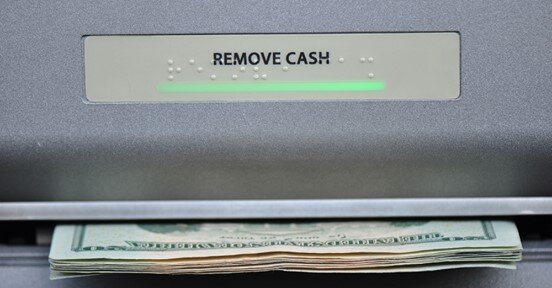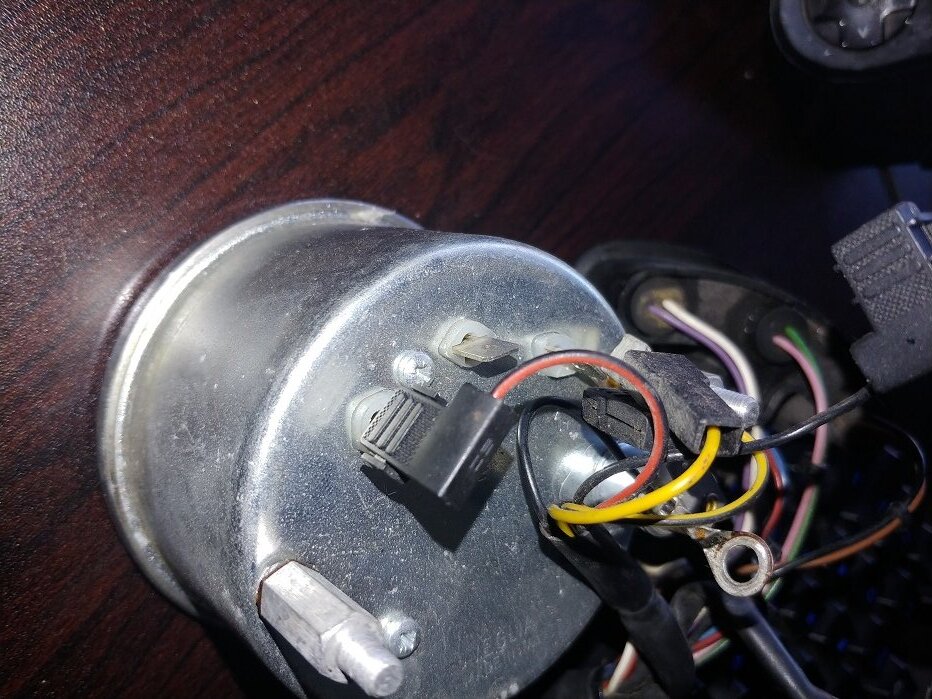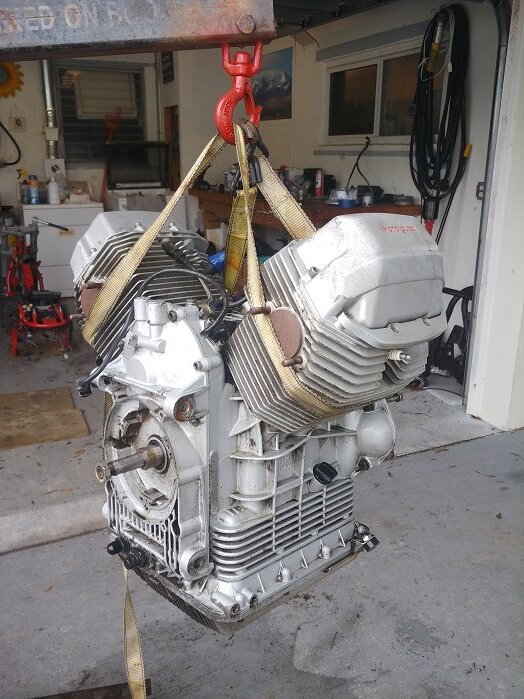-
Posts
1,752 -
Joined
-
Last visited
-
Days Won
76
Content Type
Profiles
Forums
Events
Gallery
Community Map
Everything posted by Pressureangle
-

ANSWERED Is my Electrosport Stator Defective?
Pressureangle replied to Sam P's topic in Technical Topics
Plugs to stock harness, has charge lamp circuit. Should be a no-brainer. 'Still collating data', Ash would say. -
Feh, I'm far more likely to tip it over in the gravel parking lot at zero mph than to actually crash it. If I tip over, saved the pipes. If I crash it, I doubt the head guards will add much to the bill, and might save the pipe. And at least currently, the heads are available whereas Daytona heads, not so much.
-

ANSWERED Is my Electrosport Stator Defective?
Pressureangle replied to Sam P's topic in Technical Topics
Ok, let's get serious. Documented points of failure; 30a fuse, fuse holder, wire terminals Charge wire to battery Yellow gen-to-VR wires (I had this one, and the bike I have up right now shows heat burns at the junction, even though they've had the connectors eliminated) Since you have a non-stock VR, let's have a pic so we can see the wires; I have a Shindengen on my Aermacchi, it has 3 yellow inputs, a ground, and a battery charge wire. There is no separate sensor wire, or 'illumination' wire for a charge lamp. Yours must have a lamp wire? To test a wire where there is no access, you have to puncture it- not a fan. Your generator is making voltage, you still seem worried about how high it is; a permanent magnet generator makes voltage as a function of RPM so it's normal and nothing to worry about. The next steps are; 1. See that generator voltage is received at the VR. I would allow the assumption that if you make a firm connection at the yellow wire junctions, this is true. 2. See that the VR is giving 13.5-15volts DC as near to the VR as you can measure- the first connection. You can measure this without disconnecting the VR from the system. 3. If the VR has voltage, you have to confirm voltage without drop across every connection and wire all the way to the battery. You need a test light for this, as a DMM can measure open circuit voltage that has no amperage and you can't tell. A test lamp demands current to light. The DMM can measure voltage drop across a connection, you should never have more than *-.05v* across any connection. Between the two devices you can chase the fault all the way back to the battery. If the VR never makes more than 13v, or if it makes above 15, it's suspect but still subject to measuring voltage across faulty connections. A good starting place is the fuse block. Every fuse should always have full battery voltage. If you find that any fuse measures less voltage than the battery itself, either key off or engine running, you have a faulty connection. Have a good look at the ring terminals that attach to the battery itself, to see that they're not corroded beneath the insulation. -
After having a BMW for 20k miles now, and a little history, it's my belief that BMW and MG have worked closely together for some time; not partnership, but fundamentals. In the beginning of the Italian V-twin era, I think everyone saw how sound the BMW flat twin was, the shaft drive, and removed the biggest impediment to racing them- the flatness. Plus, being Mountain Italians they gave them frames that worked and of course instantly recognized the romantic sound. Looking at the Lambretta frame above, it's clear that it's very similar to Aermacchi frames. I think the Bavarians and ItAlpians went to the same schools. Or ski trips, or wars, or something.
-

ANSWERED Is my Electrosport Stator Defective?
Pressureangle replied to Sam P's topic in Technical Topics
Has someone replaced the instrument warning lamps with LED? The charge lamp, with the stock or stock-arranged VR needs an incandescent bulb to work. By the schematic, the headlamp bulb itself has no effect- it takes power from the same wire but isn't between the charge lamp and regulator. -

Roper plates and occasional other bits
Pressureangle replied to Pressureangle's topic in Personal Ads
Surely- but I can't say just what the cost might be- may be less expensive to order a bag of 30 direct from the source. Lemme find it. Got them here- I'm sure they'd be glad to send direct. https://www.ebay.com/itm/235492214044?_skw=10pcs+sf-1+0808+self+lubricating+bearing+bushing+sleeve+8+x+10+x+8mm&itmmeta=01K555MNR051M09HMSJM535H5A&hash=item36d46e051c:g:AusAAOSwkuVbUCh8 -
Was that tightening or loosening? Looks like you might still have a bit sticking above the gasket surface.
-

best place to get red valve covers & matte grey frame plates?
Pressureangle replied to fastaussie's topic in 24/7 V11
You should see what I do to myself. I buy bikes a breaker may not pay for and try to rehabilitate them. -
I figured since this subforum doesn't move much it's a good place to stick and edit for sale stuff... Roper slosh plates, obviously (Rusty star picket project) I bought throttle body bushings, and since I have 3 bikes that take the same ones I bought a bag of 30 to get the discount. Had to order offshore and took 2 weeks- odd size in the US. If anybody wants a set, I'll send them along for postage and a donut. CA cycleworks has the seals. I'm going to find a set of common injectors and have them ready to ship out, that way members can have them on hand for a quick swap, and send theirs to me without losing ride time. I made a nice stainless replacement rod for my rusty TB linkage. I don't have ends but swap yours on or find new from Volvo, Yamaha etc. $35 shipped to US. One day I'll have the plastic adjustment knobs for the TB linkage. In the works but not yet available.
-

best place to get red valve covers & matte grey frame plates?
Pressureangle replied to fastaussie's topic in 24/7 V11
Eeee...ooooh... I think you're looking at anodizing or powdercoating. New parts are at best hard to find, and those pieces in particular seems unlikely, in good condition. -

V11 misfire around 2000 rpm, or in need of mapping?
Pressureangle replied to fastaussie's topic in Technical Topics
Rut Roh the Demon raises it's ugly head again. I think Power Commanders are universally despised by anyone not selling them. Before any root cause can be determined, a thorough precision tune-up is mandated. Also, both my '97 1100 Sport-i and my 2000 V11 Sport had a large differential in the injectors. After a quarter century, they need serviced. https://www.injectorrx.com/ -
The shorter list is 'what have I *not* f'd up through the years'.
-

ANSWERED Is my Electrosport Stator Defective?
Pressureangle replied to Sam P's topic in Technical Topics
Yes, it is. Current should flow through the ignition switch, fuse, headlight switch, and up to the tach where it passes through to the charge lamp; the regulator seeing no input from the generator passes that current through to ground, illuminating the lamp. When the generator charges the regulator, it puts an opposing charge back into the lamp wire. When these are balanced, the lamp is dark. So it seems likely that you have a problem on the power side of the regulator with a less likely possibility that the regulator has some weird internal failure. A simple test would be key-on engine off test light (not DMM) at the lamp wire + post on the back of the tach. No light, no current. -

Gratuitous Pics of Girls + Guzzi
Pressureangle replied to sign216's topic in Special place for banter and conversation
Almost forgot to notice it's not a MG lol -

ANSWERED Is my Electrosport Stator Defective?
Pressureangle replied to Sam P's topic in Technical Topics
After a short nap I have to go a little deeper. The red/black wire on the tach does not go to ground, so the tach ground is not likely an issue. Phil had said at the beginning that the VR takes it's signal through the headlight circuit, and that's the case here. The yellow wire is hot to the tach through the headlight switch, which powers through the F6 fuse, which powers through the keyswitch. So, what the lamp sees as system voltage is whatever makes it's way through all these junctions, switches, and connections; every connection introduces some resistance, and every resistance is telling the VR to output more power. Taking the brute force approach, I'd run a jumper wire directly from battery + to the headlight socket yellow wire, bypassing everything and seeing if the regulator then acts right. Understand I operate under the parable, 'A man teaches best that which he most needs to learn' and before now I haven't reviewed any of the later-than-my-97 V11 wiring, but it's relevant to my own efforts at the moment so time spent here is as valuable to me as it hopefully will be to you. -

ANSWERED Is my Electrosport Stator Defective?
Pressureangle replied to Sam P's topic in Technical Topics
Here's a link to *a* schematic- for 2004. If anyone has a good 2000-2001 schematic, particularly in English (Did KiwiRoy do this?) I'd like to see it. https://www.thisoldtractor.com/mg_manuals/wiring_v11-without-catalytic-converter_2004_it-en-fr-de.pdf Here are the Italian color translations Italian Color Name English Equivalent Notes Rosso Red Standard red; can imply a vibrant or warm shade. Blu Blue General term for blue, covering various shades. Giallo Yellow Standard yellow, from bright to mustard tones. Verde Green General green, encompassing light to dark shades. Nero Black Pure black, used universally. Bianco White Pure white, used universally. Arancione Orange Standard orange, derived from "arancia" (orange fruit). Viola Purple General purple, from light lavender to deep violet. Rosa Pink General pink, often a soft or medium shade. Marrone Brown Standard brown, often warm or earthy. Grigio Gray General gray, from light to dark shades. Azzurro Light Blue / Sky Blue A softer, brighter blue, often associated with the sky. Celeste Sky Blue / Pale Blue Lighter than azzurro, often used for pastel or baby blue. Beige Beige Neutral, light brownish-yellow, same as English usage. Avorio Ivory Off-white with a creamy or yellowish tint. Oro Gold Metallic or bright yellow-gold shade. Argento Silver Metallic gray or silver shade. Turchese Turquoise Blue-green shade, similar to the gemstone. Cremisi Crimson Deep, rich red with a slight purple undertone. Porpora Purple / Deep Red Historically a reddish-purple or deep scarlet, depending on context. Ocra Ochre Earthy yellow-brown, often used in art or design. Smeraldo Emerald Rich, deep green, like the gemstone. Zaffiro Sapphire Deep, vibrant blue, like the gemstone. Amaranto Amaranth / Magenta A reddish-purple or deep pinkish-red shade. Ciano Cyan Bright blue-green, often used in design or printing. Magenta Magenta Vibrant pinkish-purple, same as English usage. Carminio Carmine Bright, vivid red with a slight orange undertone. Bordeaux Burgundy Deep red, like the wine, with a purple tint. Ecru Ecru Unbleached linen color, pale beige or off-white. So it looks like the regulator has a light blue wire to sense voltage- this aligns with mine, though it's been cut away from the harness- the light (AZ) wire passes through a couple of connectors, then the 'charge' lamp, then to the tachometer +. When the differential between the regulator and the system reaches a sufficient level, the lamp illuminates- this also explains (probably) the high-rpm lamp, in that at low speed the current flows one way, in an overcharge state the current flows the opposite direction. By the schematic, I'd start looking at the back of the Tacho where the wire from the charge lamp connects. That wire on my 2000 is Red/Black, traced from the charge lamp to the + terminal on the tacho. If the Tacho ground is bad, that could be the issue, and they're famous for poor grounds. Pic for visibility -
My skeleton has skeletons it it's own closet. I used to pop Advil like chicklets. Best thing I ever did for joint pain is quit sugar and carbs. (mostly). Next best is to take Curcumin (Turmeric) supplements. No liver/kidney problems and a great anti-inflammatory. My Dad takes beetroot chewies and says they work too. Worth a shot.
-
Let's have a photo. As stated, left-handed drill bits are a good investment. If you're ham-fisted and meat headed as I am. *if* you have anything protruding above the gasket surface, you can clean everything spotless with acetone and JB weld (or actual weld, if equipment) a nut to the broken part. A handy welder can make it happen even if it's a bit below surface.
-

Twenty-first (XXI) South'n Spine Raid 2025
Pressureangle replied to docc's topic in Meetings, Clubs & Events
- 124 replies
-
- 10
-

-

-

ANSWERED Is my Electrosport Stator Defective?
Pressureangle replied to Sam P's topic in Technical Topics
But before you blame the regulator, you *must* verify the system voltage value the regulator sees. The way an electronic regulator works, is not to control voltage absolutely but rather to deliver rectified (DC) voltage to the battery in very short bursts (PWM, or pulse width modulation) So your battery will actually see much higher voltage than your multimeter reads for very short periods. Your DMM, unless a very high-end one where you can choose, will default to measuring by RMS (root mean square) or a fancy way of saying 'average voltage over time'. If your regulator can't actually see what's happening at the battery, it just goes WFO hoping to see a signal to turn itself off, rinse and repeat in microscopic intervals. Message is, verify your voltage regulator sensor circuit. Replace the LED bulb with an incandescent one for testing. Doesn't have to be the same size even, just plugs in and something around 50-100 watts. -
Are those exhaust/head guards a factory accessory, production upgrade, or custom aftermarket? Not sure they add to the looks, but certainly better than a flat spot and scrapes on the pipe.
-

ANSWERED Is my Electrosport Stator Defective?
Pressureangle replied to Sam P's topic in Technical Topics
I don't know, and don't recall any discussion or discovery of what conditions set the 'charge' lamp other than insufficiency. There may be some sort of current-limiting self-protection routine? I can't find a logical way that a permanent magnet generator can stop producing at higher RPM, then return to producing at low RPM. It is perfectly possible, though, that the charge wires from the generator to the VR get very hot at high RPM and the resistance cuts throughput. <shrug> only the DMM knows for sure. -

ANSWERED Is my Electrosport Stator Defective?
Pressureangle replied to Sam P's topic in Technical Topics
It's late and I'm speaking out of turn because I have neither my VR nor a schematic at hand to review. The voltage regulator has to know, by some circuit, how much voltage it 'needs' to put out. If the 'sensor' circuit has high resistance, that will tell the VR that the 'system' voltage is low and it needs to output more, when in fact the battery is charged but the regulator can't see it. I'm going through a well-worn 2000 V11 right now, and one thing that seems consistent is the ignition switches festering internally. Poor connections cause high resistance and low voltages across the board. The switches are not difficult to disassemble and clean. First things first, get a multimeter and a note pad and record what your static, or key-off battery voltage is; what your idle battery voltage is; what your 3000 RPM battery voltage is; and whether, and by how much, the battery voltage changes when the charge lamp comes on. -
I'm always amazed to find that ... most? MG riders, at least those who put on a lot of miles, simply ignore cleaning their bikes. I'm not a museum keeper, but the BMW GSA I've put near 20k miles on was not near this soupy, even though I never washed it more thoroughly that a quick sponge and ride in the rain. This thing looked like a big block chevy out of a 1975 motorhome with 100k miles on it. Not trying to be harsh, but DANG boy.
-
Those are the stock Marzocchis, cleaned and serviced by WMR Performance, my local Ohlins/WP pro shop. KTM/Husq/GasGas dealer.





